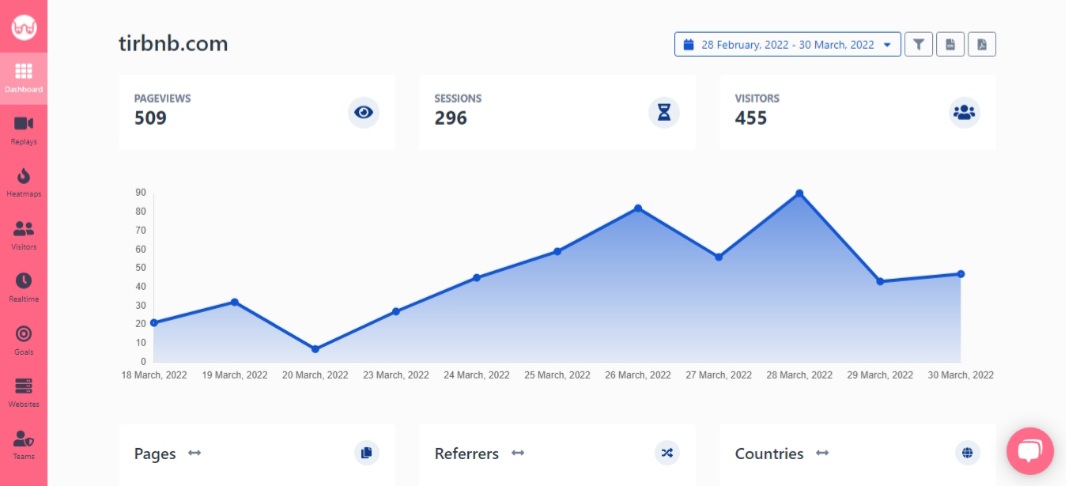Page Contents
Any business should be tracking how customers engage with their product. There are so many user engagement metrics to measure, and you can’t track all of them. User engagement metrics measure customers’ engagement with your product or content. Measuring these metrics uncovers valuable data about your business and helps you increase engagement.
Note: To understand if your content is engaging enough or not, you need a customer analytics tool. WatchThemLive, as one of the best analytics tools, lets you know if your target audience is engaging with your product or not by capturing their movement, pageviews, and sessions.
To know the most important user engagement metrics keep reading.
1. DAU, WAU, MAU
The first user engagement metrics on our list are DAU, WAU, MAU. Businesses need to track user activity over a period of time: daily active users, weekly active users, monthly active users. The definition of activity depends on your business. Sometimes it’s the number of log-ins, the number of followers of your social media platform, clicking on a specific item, etc.
2. NPS
NPS or net promoter score is one of the user engagement metrics that help you understand if customers are going to recommend you to their family and friends. For measuring NPS, you ask customers, on a scale from 0 to 10, how likely it is that you recommend us to your friends?


You can segment them based on their answers:
- Detractors: They are the ones who rate you between 0-6. They’re unsatisfied with you, and not only will they not recommend you, but they will bad-mouth you.
- Passives: They are the users who rate you between 7-8. They like your brand, but they need a push to become loyal customers. They might recommend you to their friends, or they might not do so. Either way, they won’t stop others from purchasing from you.
- Promoters: They are the ones who rate you between 9-10. They are your loyal customers and will recommend you to their friends.
How to Calculate NPS?
For calculating NPS, you should subtract the percentage of detractors from the percentage of promoters.
3. Session Duration
Session duration is one of the user engagement metrics that measures the average time a visitor spends on your website. Knowing the average session length of your blog posts helps you create the content your audience loves the most. Because if users are spending more time on one of your blog posts, this shows that they are interested in this type of content.
You should know that low session duration is not always a bad thing. It can also mean that the customer journey was smooth, and they could easily reach the goal they had in mind.
However, measuring session duration is a bit tricky. For example, let’s say a customer completes your sales funnel faster than another user. Are they missing something? Was the sales funnel confusing? Or was it smooth enough that they went through it so fast?
For fixing this issue, you need session reply software. It will record the users’ whole journey from the moment they enter your website until they leave. Also, it shows you the customers’ exact session duration and the number of page views and tracked events. Here’s a video of WatchThemLive’s session replay:
Sign up here and get started with WatchThemLive’s session replays now.
4. Churn Rate
Churn rate is the number of users who stopped using your product during a given time. Measuring churn rate helps you understand why customers are leaving or stop the ones who are on the verge of churning. In addition to measuring churn rate, you can ask for customer reviews for a better understanding.
How to Calculate Churn Rate?
For calculating the churn rate, you can simply divide the number of churned customers by the number of all the customers you had in a given period of time.
5. Retention Rate
Retention rate is the opposite of churn rate and indicates the percentage of users who continue using your product over a given period. Retention rate is one of the most important user engagement metrics for SaaS companies. A high retention rate means your customers are content with your brand, and you are successful at acquiring new customers.
How to Calculate Retention Rate?
For calculating retention rate, you should divide the percentage of customers who stayed with you by the percentage of people you had at the beginning of given period of time.
6. Conversion Rate
Conversion rate is one of the most important user engagement metrics. Conversion can mean different things based on your business. Sometimes it’s signing up on your website, filling out a form, purchasing, etc.
How to Calculate Conversion Rate?
You can calculate conversion rate simply by dividing the percentage of users who complete a certain action by the percentage of all of the users.
For example, imagine that your goal is for your visitors to subscribe to your weekly newsletter. 1000 users visited your website, and 500 of them signed up for your newsletter. So, your conversion rate is 50%.
7. Bounce Rate
Bounce rate, as one of the user engagement metrics, measures the number of users who entered your website but left without any interaction. The lower your bounce rate, the better! A high bounce rate indicates that there might be several problems with your website, such as slow page loading, 404 errors, misleading or irrelevant content, not having a good mobile user experience, etc. However, some users bounce because they are only looking for quick information. For example, they want to know the pricing of a product. They just check the pricing and leave; keep this in mind while calculating your bounce rate.
How to Calculate Bounce Rate?
Bounce rate is calculated by dividing the percentage of single sessions by the percentage of all of the sessions. For example, if you have 2000 users visiting your landing page, and 200 of them leave without visiting another page, your bounce rate would be 10%.
8. Number of Logins
Number of logins is one of the engagement KPIs that shows users are actively using your product by logging in. Tracking the daily, weekly, and monthly number of logins helps you understand if a user has not been engaging with your product lately. This way, you can start searching for issues and fixing them.
9. Pageviews
First of all, you should know that the pageviews engagement metric is not the number of people visiting your website. Pageviews indicates the number of people who visit the pages on your website, including any load, re-load, or revisiting of a single page. A high pageview rate shows that visitors are finding your content valuable and engaging. In contrast, a low pageview rate shows that you’re not creating the kind of content your audience wants and needs.
How to Calculate Pageviews?
For calculating page views, you can easily divide the number of pageviews by total visits.
First, you need to know the number of page views. WatchThemLive’s analytics tool gives you the number of pageviews and so much other useful information.


Sign up for FREE and see what’s next!
10. Stickiness
Stickiness is another customer engagement metric that shows how often users are coming back to use your product. This shows if your product is fixing customers’ problems and if they will stick with you.
How to Calculate Stickiness?
To calculate stickiness, simply divide the number of daily active users by monthly active users.
Conclusion
In the marketing world, there are thousands of customer engagement metrics; however, it’s not possible to track all of them.
In this article, we explained the top user engagement metrics that would benefit you the most. These metrics help you measure user engagement on your website and show if your business efforts are paying off. Without engagement analytics, you are not able to understand if you’re going in the right direction or if your marketing efforts are working out
Also, one of the best ways to measure user engagement metrics such as pageviews, bounce rate, conversion rate, session duration, churn rate, etc. is using a behavior analytics tool such as WatchThemLive. This tool shows visitors’ interaction with your website as well as collecting quantitative data about them.
Don’t waste any more time; sign up here and get started.


